Yikang Shen
Do Larger Language Models Imply Better Reasoning? A Pretraining Scaling Law for Reasoning
Apr 04, 2025Abstract:Large Language Models (LLMs) have demonstrated remarkable capabilities across a wide range of tasks requiring complex reasoning. However, the effects of scaling on their reasoning abilities remain insufficiently understood. In this paper, we introduce a synthetic multihop reasoning environment designed to closely replicate the structure and distribution of real-world large-scale knowledge graphs. Our reasoning task involves completing missing edges in the graph, which requires advanced multi-hop reasoning and mimics real-world reasoning scenarios. To evaluate this, we pretrain language models (LMs) from scratch solely on triples from the incomplete graph and assess their ability to infer the missing edges. Interestingly, we observe that overparameterization can impair reasoning performance due to excessive memorization. We investigate different factors that affect this U-shaped loss curve, including graph structure, model size, and training steps. To predict the optimal model size for a specific knowledge graph, we find an empirical scaling that linearly maps the knowledge graph search entropy to the optimal model size. This work provides new insights into the relationship between scaling and reasoning in LLMs, shedding light on possible ways to optimize their performance for reasoning tasks.
Stick-breaking Attention
Oct 23, 2024



Abstract:The self-attention mechanism traditionally relies on the softmax operator, necessitating positional embeddings like RoPE, or position biases to account for token order. But current methods using still face length generalisation challenges. We propose an alternative attention mechanism based on the stick-breaking process: For each token before the current, we determine a break point $\beta_{i,j}$, which represents the proportion of the remaining stick to allocate to the current token. We repeat the process until the stick is fully allocated, resulting in a sequence of attention weights. This process naturally incorporates recency bias, which has linguistic motivations for grammar parsing (Shen et. al., 2017). We study the implications of replacing the conventional softmax-based attention mechanism with stick-breaking attention. We then discuss implementation of numerically stable stick-breaking attention and adapt Flash Attention to accommodate this mechanism. When used as a drop-in replacement for current softmax+RoPE attention systems, we find that stick-breaking attention performs competitively with current methods on length generalisation and downstream tasks. Stick-breaking also performs well at length generalisation, allowing a model trained with $2^{11}$ context window to perform well at $2^{14}$ with perplexity improvements.
Power Scheduler: A Batch Size and Token Number Agnostic Learning Rate Scheduler
Aug 23, 2024Abstract:Finding the optimal learning rate for language model pretraining is a challenging task. This is not only because there is a complicated correlation between learning rate, batch size, number of training tokens, model size, and other hyperparameters but also because it is prohibitively expensive to perform a hyperparameter search for large language models with Billions or Trillions of parameters. Recent studies propose using small proxy models and small corpus to perform hyperparameter searches and transposing the optimal parameters to large models and large corpus. While the zero-shot transferability is theoretically and empirically proven for model size related hyperparameters, like depth and width, the zero-shot transfer from small corpus to large corpus is underexplored. In this paper, we study the correlation between optimal learning rate, batch size, and number of training tokens for the recently proposed WSD scheduler. After thousands of small experiments, we found a power-law relationship between variables and demonstrated its transferability across model sizes. Based on the observation, we propose a new learning rate scheduler, Power scheduler, that is agnostic about the number of training tokens and batch size. The experiment shows that combining the Power scheduler with Maximum Update Parameterization (muP) can consistently achieve impressive performance with one set of hyperparameters regardless of the number of training tokens, batch size, model size, and even model architecture. Our 3B dense and MoE models trained with the Power scheduler achieve comparable performance as state-of-the-art small language models. We open-source these pretrained models at https://ibm.biz/BdKhLa.
FlexAttention for Efficient High-Resolution Vision-Language Models
Jul 29, 2024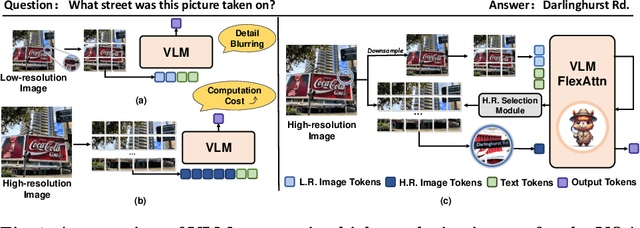
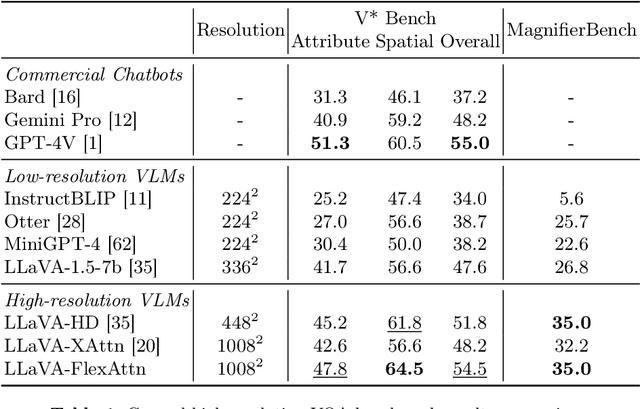
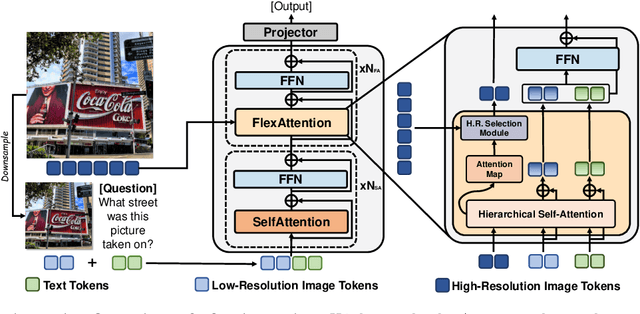
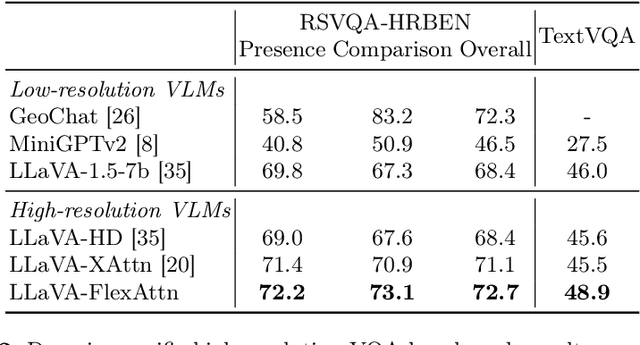
Abstract:Current high-resolution vision-language models encode images as high-resolution image tokens and exhaustively take all these tokens to compute attention, which significantly increases the computational cost. To address this problem, we propose FlexAttention, a flexible attention mechanism for efficient high-resolution vision-language models. Specifically, a high-resolution image is encoded both as high-resolution tokens and low-resolution tokens, where only the low-resolution tokens and a few selected high-resolution tokens are utilized to calculate the attention map, which greatly shrinks the computational cost. The high-resolution tokens are selected via a high-resolution selection module which could retrieve tokens of relevant regions based on an input attention map. The selected high-resolution tokens are then concatenated to the low-resolution tokens and text tokens, and input to a hierarchical self-attention layer which produces an attention map that could be used for the next-step high-resolution token selection. The hierarchical self-attention process and high-resolution token selection process are performed iteratively for each attention layer. Experiments on multimodal benchmarks prove that our FlexAttention outperforms existing high-resolution VLMs (e.g., relatively ~9% in V* Bench, ~7% in TextVQA), while also significantly reducing the computational cost by nearly 40%.
Scaling Granite Code Models to 128K Context
Jul 18, 2024Abstract:This paper introduces long-context Granite code models that support effective context windows of up to 128K tokens. Our solution for scaling context length of Granite 3B/8B code models from 2K/4K to 128K consists of a light-weight continual pretraining by gradually increasing its RoPE base frequency with repository-level file packing and length-upsampled long-context data. Additionally, we also release instruction-tuned models with long-context support which are derived by further finetuning the long context base models on a mix of permissively licensed short and long-context instruction-response pairs. While comparing to the original short-context Granite code models, our long-context models achieve significant improvements on long-context tasks without any noticeable performance degradation on regular code completion benchmarks (e.g., HumanEval). We release all our long-context Granite code models under an Apache 2.0 license for both research and commercial use.
The infrastructure powering IBM's Gen AI model development
Jul 07, 2024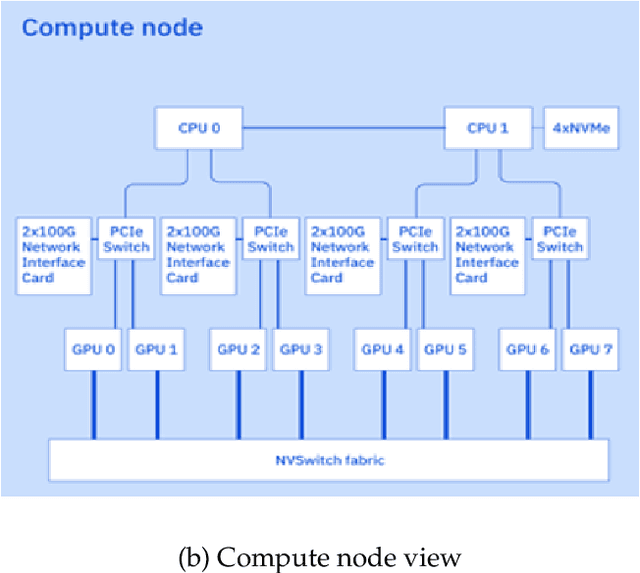
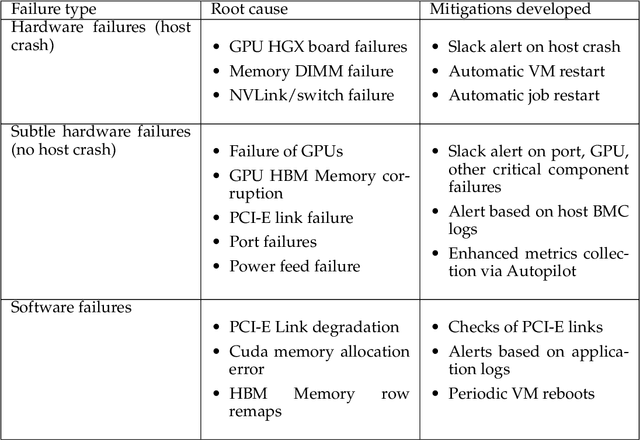
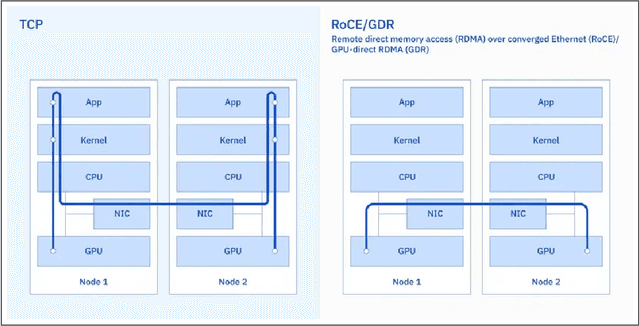

Abstract:AI Infrastructure plays a key role in the speed and cost-competitiveness of developing and deploying advanced AI models. The current demand for powerful AI infrastructure for model training is driven by the emergence of generative AI and foundational models, where on occasion thousands of GPUs must cooperate on a single training job for the model to be trained in a reasonable time. Delivering efficient and high-performing AI training requires an end-to-end solution that combines hardware, software and holistic telemetry to cater for multiple types of AI workloads. In this report, we describe IBM's hybrid cloud infrastructure that powers our generative AI model development. This infrastructure includes (1) Vela: an AI-optimized supercomputing capability directly integrated into the IBM Cloud, delivering scalable, dynamic, multi-tenant and geographically distributed infrastructure for large-scale model training and other AI workflow steps and (2) Blue Vela: a large-scale, purpose-built, on-premises hosting environment that is optimized to support our largest and most ambitious AI model training tasks. Vela provides IBM with the dual benefit of high performance for internal use along with the flexibility to adapt to an evolving commercial landscape. Blue Vela provides us with the benefits of rapid development of our largest and most ambitious models, as well as future-proofing against the evolving model landscape in the industry. Taken together, they provide IBM with the ability to rapidly innovate in the development of both AI models and commercial offerings.
Octo-planner: On-device Language Model for Planner-Action Agents
Jun 26, 2024



Abstract:AI agents have become increasingly significant in various domains, enabling autonomous decision-making and problem-solving. To function effectively, these agents require a planning process that determines the best course of action and then executes the planned actions. In this paper, we present an efficient on-device Planner-Action framework that separates planning and action execution into two distinct components: a planner agent based on Phi-3 Mini, a 3.8 billion parameter LLM optimized for edge devices, and an action agent using the Octopus model for function execution. The planner agent first responds to user queries by decomposing tasks into a sequence of sub-steps, which are then executed by the action agent. To optimize performance on resource-constrained devices, we employ model fine-tuning instead of in-context learning, reducing computational costs and energy consumption while improving response times. Our approach involves using GPT-4 to generate diverse planning queries and responses based on available functions, with subsequent validations to ensure data quality. We fine-tune the Phi-3 Mini model on this curated dataset, achieving a 97\% success rate in our in-domain test environment. To address multi-domain planning challenges, we developed a multi-LoRA training method that merges weights from LoRAs trained on distinct function subsets. This approach enables flexible handling of complex, multi-domain queries while maintaining computational efficiency on resource-constrained devices. To support further research, we have open-sourced our model weights at \url{https://huggingface.co/NexaAIDev/octopus-planning}. For the demo, please refer to \url{https://www.nexa4ai.com/octo-planner}.
Efficient Continual Pre-training by Mitigating the Stability Gap
Jun 21, 2024Abstract:Continual pre-training has increasingly become the predominant approach for adapting Large Language Models (LLMs) to new domains. This process involves updating the pre-trained LLM with a corpus from a new domain, resulting in a shift in the training distribution. To study the behavior of LLMs during this shift, we measured the model's performance throughout the continual pre-training process. we observed a temporary performance drop at the beginning, followed by a recovery phase, a phenomenon known as the "stability gap," previously noted in vision models classifying new classes. To address this issue and enhance LLM performance within a fixed compute budget, we propose three effective strategies: (1) Continually pre-training the LLM on a subset with a proper size for multiple epochs, resulting in faster performance recovery than pre-training the LLM on a large corpus in a single epoch; (2) Pre-training the LLM only on high-quality sub-corpus, which rapidly boosts domain performance; and (3) Using a data mixture similar to the pre-training data to reduce distribution gap. We conduct various experiments on Llama-family models to validate the effectiveness of our strategies in both medical continual pre-training and instruction tuning. For example, our strategies improve the average medical task performance of the OpenLlama-3B model from 36.2% to 40.7% with only 40% of the original training budget and enhance the average general task performance without causing forgetting. Furthermore, we apply our strategies to the Llama-3-8B model. The resulting model, Llama-3-Physician, achieves the best medical performance among current open-source models, and performs comparably to or even better than GPT-4 on several medical benchmarks. We release our models at \url{https://huggingface.co/YiDuo1999/Llama-3-Physician-8B-Instruct}.
Parallelizing Linear Transformers with the Delta Rule over Sequence Length
Jun 10, 2024Abstract:Transformers with linear attention (i.e., linear transformers) and state-space models have recently been suggested as a viable linear-time alternative to transformers with softmax attention. However, these models still underperform transformers especially on tasks that require in-context retrieval. While more expressive variants of linear transformers which replace the additive outer-product update in linear transformers with the delta rule have been found to be more effective at associative recall, existing algorithms for training such models do not parallelize over sequence length and are thus inefficient to train on modern hardware. This work describes a hardware-efficient algorithm for training linear transformers with the delta rule, which exploits a memory-efficient representation for computing products of Householder matrices. This algorithm allows us to scale up DeltaNet to standard language modeling settings. We train a 1.3B model for 100B tokens and find that it outperforms recent linear-time baselines such as Mamba and GLA in terms of perplexity and zero-shot performance on downstream tasks (including on tasks that focus on recall). We also experiment with two hybrid models which combine DeltaNet layers with (1) sliding-window attention layers every other layer or (2) two global attention layers, and find that these hybrid models outperform strong transformer baselines.
Stacking Your Transformers: A Closer Look at Model Growth for Efficient LLM Pre-Training
May 24, 2024Abstract:LLMs are computationally expensive to pre-train due to their large scale. Model growth emerges as a promising approach by leveraging smaller models to accelerate the training of larger ones. However, the viability of these model growth methods in efficient LLM pre-training remains underexplored. This work identifies three critical $\underline{\textit{O}}$bstacles: ($\textit{O}$1) lack of comprehensive evaluation, ($\textit{O}$2) untested viability for scaling, and ($\textit{O}$3) lack of empirical guidelines. To tackle $\textit{O}$1, we summarize existing approaches into four atomic growth operators and systematically evaluate them in a standardized LLM pre-training setting. Our findings reveal that a depthwise stacking operator, called $G_{\text{stack}}$, exhibits remarkable acceleration in training, leading to decreased loss and improved overall performance on eight standard NLP benchmarks compared to strong baselines. Motivated by these promising results, we conduct extensive experiments to delve deeper into $G_{\text{stack}}$ to address $\textit{O}$2 and $\textit{O}$3. For $\textit{O}$2 (untested scalability), our study shows that $G_{\text{stack}}$ is scalable and consistently performs well, with experiments up to 7B LLMs after growth and pre-training LLMs with 750B tokens. For example, compared to a conventionally trained 7B model using 300B tokens, our $G_{\text{stack}}$ model converges to the same loss with 194B tokens, resulting in a 54.6\% speedup. We further address $\textit{O}$3 (lack of empirical guidelines) by formalizing guidelines to determine growth timing and growth factor for $G_{\text{stack}}$, making it practical in general LLM pre-training. We also provide in-depth discussions and comprehensive ablation studies of $G_{\text{stack}}$. Our code and pre-trained model are available at $\href{https://llm-stacking.github.io/}{https://llm-stacking.github.io/}$.
 Add to Chrome
Add to Chrome Add to Firefox
Add to Firefox Add to Edge
Add to Edge